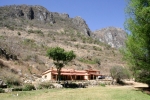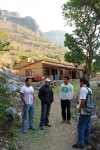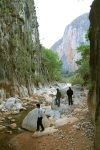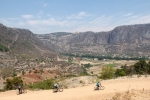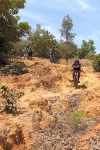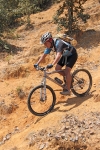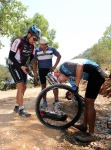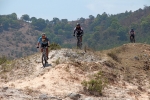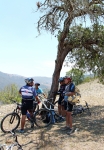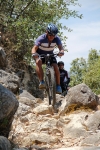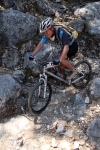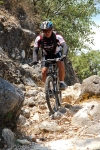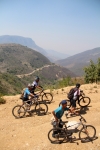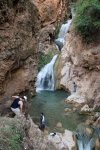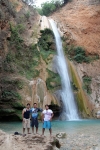Santiago Apoala is a very small (pop. 200) Mixtec village located in a deep, secluded valley 68 miles northwest of Oaxaca city. Its dramatic setting and some of the physical characteristics of the area make it a fine destination for hiking and mountain biking. The Mexican government has designated Apoala as a natural biosphere, and has constructed an ecotourism center there. The principal things of interest to visitors are the extremely narrow, vertiginous canyon that guards the northern approach to the village; the natural spring at the base of a cliff that gushes clear, frigid water year around; the various caves that riddle the nearby hillsides; and the series of scenic cascades and waterfalls created by the water flowing out of the valley and over yet another cliff. The highway between Nochixtlan and Apoala was paved in 2022, reducing the drive time from Oaxaca from 3.5 hours to just 2 hours.
Mountain bikers will find the area challenging, in part because trails are difficult to find and partly because of the technical obstacles of the terrain. Hiring a local guide to ride with you is strongly recommended — as is having a sturdy bike and being in good physical condition. Be sure to carry plenty of water and food, as you may spend a grueling day in the saddle with no opportunity to resupply. Also carry a decent supply of tools, tire repair kit and a spare tube.
Apoala es un pueblo de 200 habitantes en la Mixteca a 109 kilómetros al noreste de la Cuidad de Oaxaca. Su ubicación en un dramático paisaje lo hace un destino muy atractivo para hace paseos de “mountain biking” y para caminatas. Puesto que se necesitan tres horas y media para llegar a Apoala es mejor quesdarse dos días allá. El gobierno mexicano se ha designado a Apoala como “un biosfero natural” y ha construido un Centro de Ecoturismo. Para los visitantes los aspectos más interesantes son los barrancas estrechas y profundas que están al lado norte del pueblo, el manantial de aguas limpias y muy frías al fondo de un despeñadero, varias cuevas en las laderas, y una serie de cascadas que vienen del valle y caen de otro despeñadero.
Los que son ciclistas de las montanas encuentran el área un reto puesto que las sendas son difíciles de encontrar y los obstáculos del terreno. Se recomenda que los participantes contrate un guía local y tenga un bicicleta en óptima condición. Es importante tener consigo una buena cantidad de agua y comida dado que el viaje es agotatante y sin oportunidades de conseguir ni agua ni alimentos. Es aconsejable llevar herramientas para reparar llantas y un cámara de aire extra.
